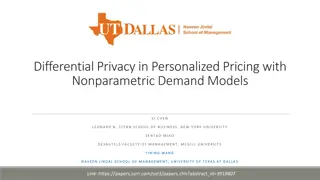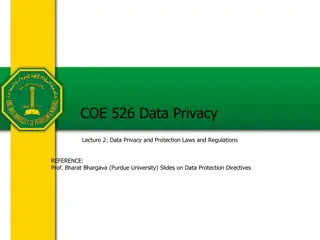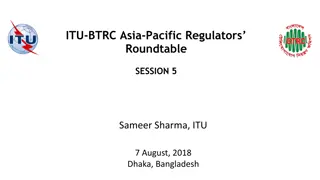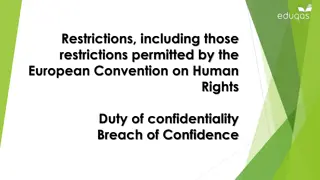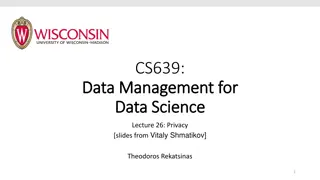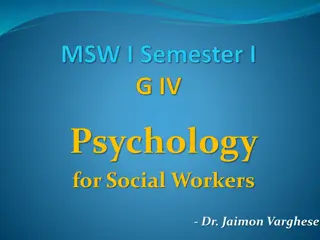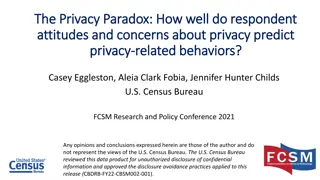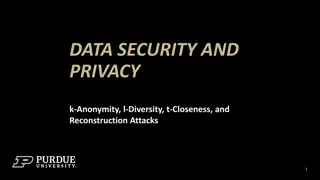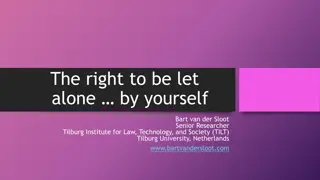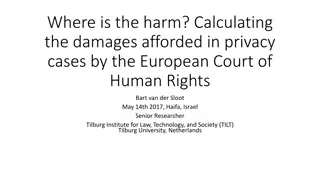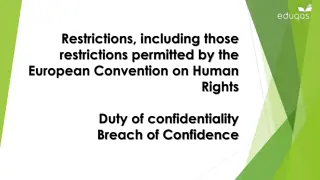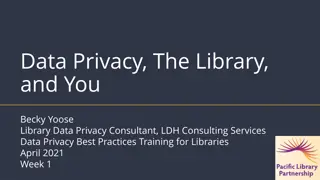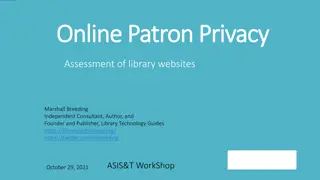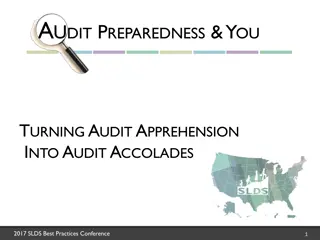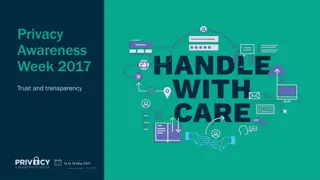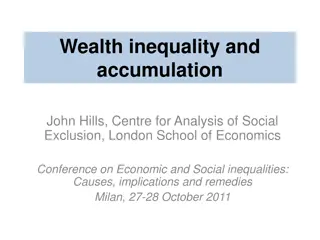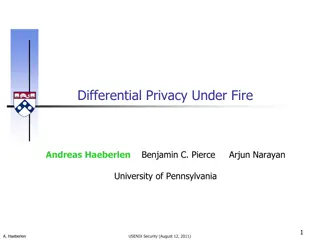Security, Privacy, and Human Behavior: Navigating the Paradoxes
Exploring the challenges of security and privacy behaviors in information systems, this content delves into the case of a security officer struggling with employee awareness, password policies, and the paradox of knowledgeable CISOs. Insights from real-life scenarios and research shed light on the importance of human factors in cybersecurity decisions.
Download Presentation

Please find below an Image/Link to download the presentation.
The content on the website is provided AS IS for your information and personal use only. It may not be sold, licensed, or shared on other websites without obtaining consent from the author. Download presentation by click this link. If you encounter any issues during the download, it is possible that the publisher has removed the file from their server.
E N D
Presentation Transcript
ICISSP 2024, Rome, Italy Security, privacy, and the human factor Making sense of the paradoxes of security and privacy behaviour Prof. Spyros Kokolakis, University of the Aegean
About the speaker Spyros Kokolakis Research interests: Privacy paradox, InfoSec awareness, InfoSec management Professor, Dept. of Information & Communication Systems Engineering, Univ. of the Aegean Web: http://spyroskokolakis.gr Email: sak@aegean.gr CIO at a medium-sized software & IoT company
Case study*: The enthusiastic security officer Panos N. 35 y.o., ISO27001 certified, experienced security officer SoftHouse S.A. Software house, cloud services, 120+ employees, several subsidiaries. ISO27001 certified. 400 words email on phishing, to all employees. Attached a 116-pages-long report. very few read it! I don t want anyone to claim that they weren t informed * Based on a true story, but some facts have been altered
Common practice: Password change NIST (SP800-63b) suggests: Do not impose composition rules Do not require passwords to be changed periodically Jan: Feb: Mar: Apr: May: June: . P1a1s1s1!@ P2a2s2s2!@ P3a3s3s3!@ P4a4s4s4!@ P5a5s5s5!@ P6a6s6s6!@ Panos, like most security officers, insists on imposing strict password change rules (30 days), although he understands that this practice is ineffective Recently, in the aftermath of a ransomware incident, the Univ. of the Aegean introduced periodical password change, despite the protest of several faculty members, including infosec experts. - Responsibility, Authority, Power
a global phenomenon BSI, the German federal office for information security, removed its suggestion to enforce regular password change in 2020. Three years later, Gerlitz et al. surveyed the adoption of the new recommendation. They found significantly low adoption. Inertia Compensation for technical issues Auditors are not convinced Caution: Reasons expressed by individuals. If they are true is unknown. Gerlitz, E., H ring, M., Smith, M., & Tiefenau, C. (2023). Evolution of password expiry in companies: measuring the adoption of recommendations by the German federal office for information security. In Nineteenth Symposium on Usable Privacy and Security (SOUPS 2023) (pp. 191-210).
The paradox of the knowledgeable CISO In all the aforementioned cases, information security professionals know what the best practices are, but they fail to act accordingly. We often witness failures in implementing strict policies and we tend to blame the lack of management support. But in this case, CISOs fail to relax policies or to communicate risks! Though there are no studies to support this claim, it is most probable that there are social and organizational factors to be blamed.
Security is scary, confusing, and dull! Negative perceptions of security prevail. Haney, J. M., & Lutters, W. G. (2018). " It's Scary It's Confusing It's Dull": How Cybersecurity Advocates Overcome Negative Perceptions of Security. In USENIX 2018. Security practices are often annoying, time consuming, and difficult to implement. Users often feel tired of trying to keep up with the demands of information security and privacy protection, become lazy or give up the effort altogether. Furnell, S., & Thomson, K. L. (2009). Recognising and addressing security fatigue . Computer Fraud & Security, 11:7- 11
The myth of Management Support SoftHouse S.A. strictly implements ISO27001, but has failed for years to contain developers access rights Developers are highly appreciated in the company and have a lot of internal political power Management has the will, but doesn t have the power Management support is a necessary, but not sufficient condition
Non-human actors: Firewall rules, filters etc. Conclusion: Security behavior depends on a complex system of motives, interests, alliances, and conflicts. We should be aware that our theoretical models constitute an oversimplification of reality. SoftHouse S.A. Rule: Access to Facebook is forbidden. Consequence: Developers do not have access to Facebook resources, e.g. ReactJS. Firewall has a rule Deny social media . The list of social networks is maintained by the firewall provider. A specific exception is needed to allow access to Facebook. The Firewall, as an artifact, influences the Internet access policy.
Power, politics, and . Markus, M. L. (1983). Power, politics, and MIS implementation. Commun. of the ACM, 26(6), 430-444. Studied information systems failures Examined popular theories of IS adoption Discovered that power games and business politics play a very important role This perspective have led, over the years, to the engagement of social and organizational theories in information systems studies
Structuration theory Showing the interplay of individuals with social structures (agency vs. structure) Structures of signification: How actors derive interpretive schemes Structures of domination: The power of actors to act Structure of legitimation: How individuals sanction their actions by referring to norms and rules Giddens, A. (1984). The Constitution of Society. Cambridge, Polity Press Jones R.M. & Karsten H. (2008) Giddens's Structuration Theory and Information Systems Research, MIS Quarterly, 32(1), 127-158
Actor-Network Theory: From diagnosis to action Latour, B. (2007). Reassembling the social: An introduction to actor-network-theory. Oxford. ANT outlines how human and non-human actors form alliances and enroll other actors to achieve goals ANT allows researchers to gain insights into the negotiations that take place among stakeholders when a technology-driven change is introduced Focus on actor s interests
Actor-Network Theory concepts Actants: Both human and non- human Translation: The process of establishing the identities and conditions of interaction Assemblage: Network of actors Obligatory passage point: A necessary element for the formation of a network and an action program Enrollment: Actors enroll in networks Focal actor: The actor initiating the alliance Actors in the network should have consistent interests Tsohou, A., Karyda, M., Kokolakis, S., & Kiountouzis, E. (2015). Managing the introduction of information security awareness programmes in organisations. European Journal of Information Systems, 24(1), 38-58.
Paradoxical human behaviour We often observe behaviour that is paradoxical , i.e. there is a discrepancy between attitudes and actions that is hard to explain. CISOs know that relaxing the password change policy is the best practice, but hesitate to implement it. People claim to value privacy, yet readily disclose their personal details. Social and organizational structures may explain some aspects of these behaviours, but we should also delve into the processes of human thinking and decision making. So, why human (security and privacy) behaviour often appears to be irrational ?
The complexity of human decision-making The rational hypothesis where rational thinking is commonly perceived as computer-like thinking! Two systems of thinking: System 1: Fast, intuitive, based on experience, automatic System 2: Analytical, reasonable The two systems work in tandem and cannot be separated. Neither system is 100% accurate. Kahneman, D. (2011). Thinking, fast and slow. Macmillan
The privacy paradox and many others Human behavior often seems irrational, but that s only because we tend to ignore or undervalue System 1. Privacy paradox: People state that they value their privacy but are willing to disclose their personal info for very small rewards. For thousands of years people survived thanks to fast, intuitive (System 1) thinking. A side-effect of humans versatility and adaptability is that they are not consistent in their behavior.
Cognitive limitations and biases System 1 uses heuristics, rather than analytical assessment processes. Human decision making is biased and has several limitations. Both systems of thinking have limitations.
Cognitive biases and heuristics A long list of cognitive biases and heuristics Also, o Cultural biases o Optimism bias o Security fatigue o Confirmation bias o Negative attitudes towards security o Anchoring o Affect heuristic o Availability heuristic o Hyperbolic time discounting
Optimism bias People systematically tend to believe that others are at higher risk to experience a negative event compared to themselves. Optimism bias has a neurological basis. It relates to an enhanced activation in specific parts of the brain when imagining positive future events relative to negative ones. As a result, people are immune to fear appeals. They understand the risks, but they are still optimistic that it won t happen to them . Optimism bias relates to the privacy paradox, to security policy non- compliance, etc. Deliver the message that no one is immune to security and privacy threats and personalize risks.
Confirmation bias People typically tend to look for information that confirms their own beliefs and may simply ignore information that challenges them. Confirmation bias has been proven to be very strong, one of the major biases affecting people s attitudes and decisions. E.g., several users may believe that security threats mostly originate from outside the organization. Presenting facts which show that insiders threat is equally important might not suffice to change this belief, as users may ignore evidence that challenge their initial hypothesis. As a result, presenting facts and figures (e.g., security reports) is often ineffective. They rarely affect people s preconceptions. Prompt users to challenge their own beliefs, to consider alternative options.
Anchoring Anchoring refers to a cognitive bias in which a person s numerical estimate is biased towards a probably irrelevant value that this person has recently heard or read. Marketing techniques often use anchoring. We wouldn t ask for a 30-characters-long password, but we strongly recommend choosing passwords well above the minimum length requirement Minimum password length requirements become anchors; thus, most users choose password length at or close to the minimum. We establish 30 as an anchor! Adopt marketing techniques to use anchoring to the benefit of security.
Affect heuristic The affect heuristic refers to a cognitive shortcut, in which current emotion influences judgements and decisions. Security-related decisions are hard to predict, they may depend on the moment's emotion. Make secure processes a habit . Also, promote a positive feeling about security, accompany security messages with pleasant images or jokes.
Hyperbolic time discounting Hyperbolic time discounting refers to the common tendency to attribute greater importance to present gains or losses than to future ones. Relates to the privacy paradox and security policy non-compliance. It may explain why people often fail to take self-protective measures. The consequences of information disclosure or loose security practices might come sometime in the future. E.g., the immediate gratification of sharing information may outweigh future security or privacy risks. Emphasize on the immediacy of consequences.
Cultural Theory of Risk and the White Male Effect Douglas, M. and Wildavsky, A. (1982). Risk and Culture: An essay on the selection of technological and environmental dangers. California University Press, Berkeley Hierarchists: Value risks that affect social order (e.g. cybercrime) Egalitarians: Value risks that affect children, weak individuals, or future generations Individualists: Tend to underestimate risks, but value risks that may limit their freedom Fatalists: Prefer to remain unaware of risks
The blind men and the elephant Psychology and cognitive science Sociology Management science Computer science & engineering
ICISSP 2024, Rome, Italy Thank you for your attention! Security, privacy, and the human factor : Making sense of the paradoxes of security and privacy behaviour



















